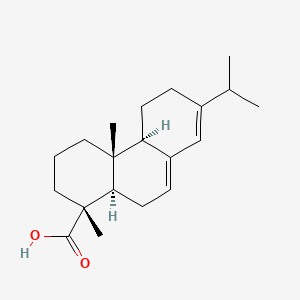| MeSH term | MeSH ID | Detail |
|---|---|---|
| Asthma | D001249 | 52 associated lipids |
| Cell Transformation, Neoplastic | D002471 | 126 associated lipids |
| Dermatitis, Contact | D003877 | 59 associated lipids |
| Edema | D004487 | 152 associated lipids |
| Occupational Diseases | D009784 | 42 associated lipids |
| Psoriasis | D011565 | 47 associated lipids |
| Ulcer | D014456 | 16 associated lipids |
| Weight Gain | D015430 | 101 associated lipids |
Abietic acid
Abietic acid is a lipid of Prenol Lipids (PR) class. Abietic acid is associated with abnormalities such as Hand eczema, Dermatitis, Vitelliform dystrophy, Wiskott-Aldrich Syndrome and Dehydration. The involved functions are known as Process, Oxidation, Anabolism, Transmembrane Transport and physiological aspects. Abietic acid often locates in Membrane, Protoplasm, Microsomes and Cellular Membrane. The associated genes with Abietic acid are SLC33A1 gene and ABCG2 gene. The related lipids are Pinene.
Cross Reference
Introduction
To understand associated biological information of Abietic acid, we collected biological information of abnormalities, associated pathways, cellular/molecular locations, biological functions, related genes/proteins, lipids and common seen animal/experimental models with organized paragraphs from literatures.
What diseases are associated with Abietic acid?
Abietic acid is suspected in Hand eczema, Dermatitis, Dehydration and other diseases in descending order of the highest number of associated sentences.
Related references are mostly published in these journals:
| Disease | Cross reference | Weighted score | Related literature |
|---|
Possible diseases from mapped MeSH terms on references
We collected disease MeSH terms mapped to the references associated with Abietic acid
PubChem Associated disorders and diseases
What pathways are associated with Abietic acid
There are no associated biomedical information in the current reference collection.
PubChem Biomolecular Interactions and Pathways
Link to PubChem Biomolecular Interactions and PathwaysWhat cellular locations are associated with Abietic acid?
Visualization in cellular structure
Associated locations are in red color. Not associated locations are in black.
Related references are published most in these journals:
| Location | Cross reference | Weighted score | Related literatures |
|---|
What functions are associated with Abietic acid?
Related references are published most in these journals:
| Function | Cross reference | Weighted score | Related literatures |
|---|
What lipids are associated with Abietic acid?
Related references are published most in these journals:
| Lipid concept | Cross reference | Weighted score | Related literatures |
|---|
What genes are associated with Abietic acid?
Related references are published most in these journals:
| Gene | Cross reference | Weighted score | Related literatures |
|---|
What common seen animal models are associated with Abietic acid?
There are no associated biomedical information in the current reference collection.
NCBI Entrez Crosslinks
All references with Abietic acid
Download all related citations| Authors | Title | Published | Journal | PubMed Link |
|---|---|---|---|---|
| Fisher AA | Allergic contact dermatitis in a violinist. The role of abietic acid--a sensitizer in rosin (colophony)--as the causative agent. | 1981 | Cutis | pmid:7016461 |
| Fisher AA | Paper dermatitis. | 1983 | Cutis | pmid:6406159 |
| Liu TP et al. | Pharmacological study of antithrombotic action of abietic acid. | 1985 | J Tradit Chin Med | pmid:3851113 |
| Karlberg AT et al. | Is abietic acid the allergenic component of colophony? | 1985 | Contact Derm. | pmid:4085221 |
| Nakamura T | Contact dermatitis to Japanese black pine. | 1986 | Contact Derm. | pmid:3743045 |
| Karlberg AT et al. | Identification of 15-hydroperoxyabietic acid as a contact allergen in Portuguese colophony. | 1988 | J. Pharm. Pharmacol. | pmid:2896772 |
| Karlberg AT et al. | Hydrogenation reduces the allergenicity of colophony (rosin). | 1988 | Contact Derm. | pmid:3180766 |
| Karlberg AT | Contact allergy to colophony. Chemical identifications of allergens, sensitization experiments and clinical experiences. | 1988 | Acta Derm Venereol Suppl (Stockh) | pmid:3188806 |
| Karlberg AT | Pure abietic acid is not allergenic. | 1989 | Contact Derm. | pmid:2598660 |
| Ayars GH et al. | The toxicity of constituents of cedar and pine woods to pulmonary epithelium. | 1989 | J. Allergy Clin. Immunol. | pmid:2926083 |
| Hausen BM et al. | Contact allergy due to colophony (VII). Sensitizing studies with oxidation products of abietic and related acids. | 1990 | Contact Derm. | pmid:2096024 |
| Ehrin E and Karlberg AT | Detection of rosin (colophony) components in technical products using an HPLC technique. | 1990 | Contact Derm. | pmid:2096025 |
| Söderberg TA | Effects of zinc oxide, rosin and resin acids and their combinations on bacterial growth and inflammatory cells. | 1990 | Scand J Plast Reconstr Surg Hand Surg Suppl | pmid:2284587 |
| Söderberg TA et al. | Antibacterial effects of zinc oxide, rosin, and resin acids with special reference to their interactions. | 1991 | Scand J Plast Reconstr Surg Hand Surg | pmid:2052904 |
| Patel GB et al. | Inhibition of pure cultures of methanogens by benzene ring compounds. | 1991 | Appl. Environ. Microbiol. | pmid:1746956 |
| Orpiszewski J et al. | Multiple forms of O-methyltransferase involved in the microbial conversion of abietic acid into methyl abietate by Mycobacterium sp. | 1991 | FEMS Microbiol. Lett. | pmid:1936951 |
| Puranik PK and Dorle AK | Study of abietic acid glycerol derivatives as microencapsulating materials. | 1991 Apr-Jun | J Microencapsul | pmid:1765905 |
| Karlberg AT and Lidén C | Colophony (rosin) in newspapers may contribute to hand eczema. | 1992 | Br. J. Dermatol. | pmid:1536781 |
| Puranik PK et al. | Preparation and evaluation of abietic acid microcapsules by a solvent evaporation technique. | 1992 Oct-Dec | J Microencapsul | pmid:1403490 |
| Hausen BM et al. | Contact allergy due to colophony. (IX). Sensitization studies with further products isolated after oxidative degradation of resin acids and colophony. | 1993 | Contact Derm. | pmid:8112061 |
